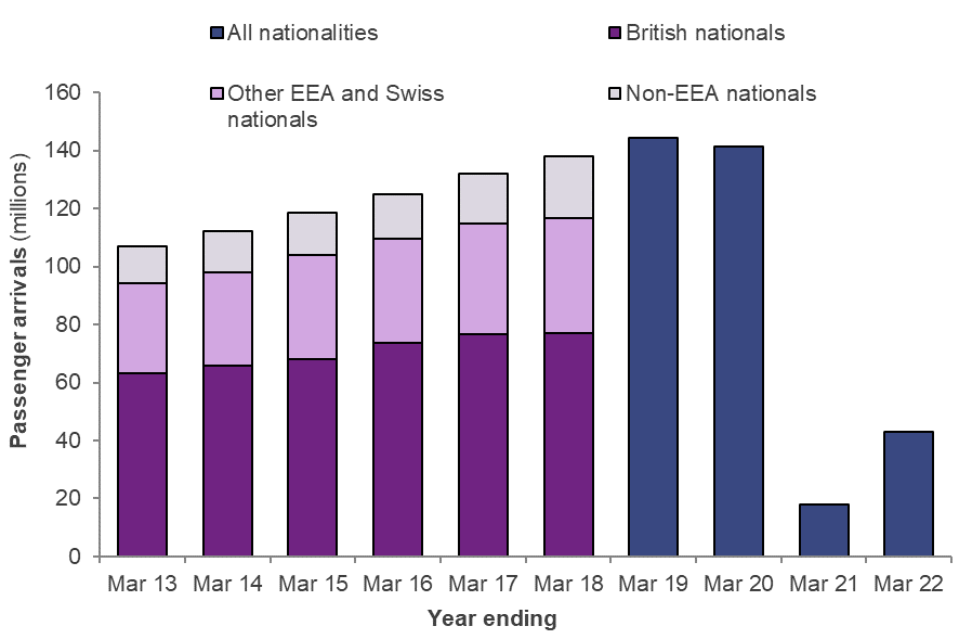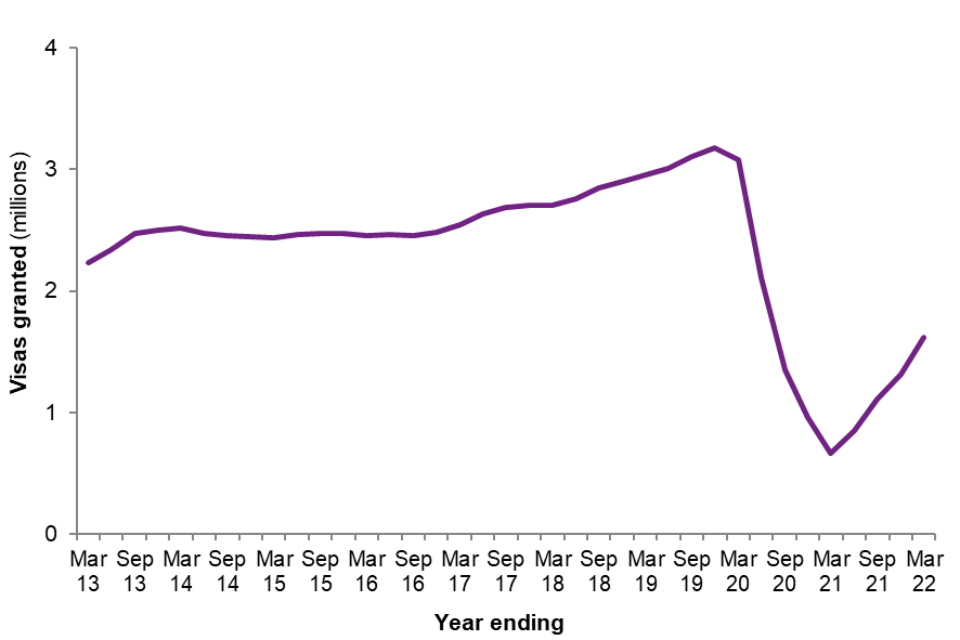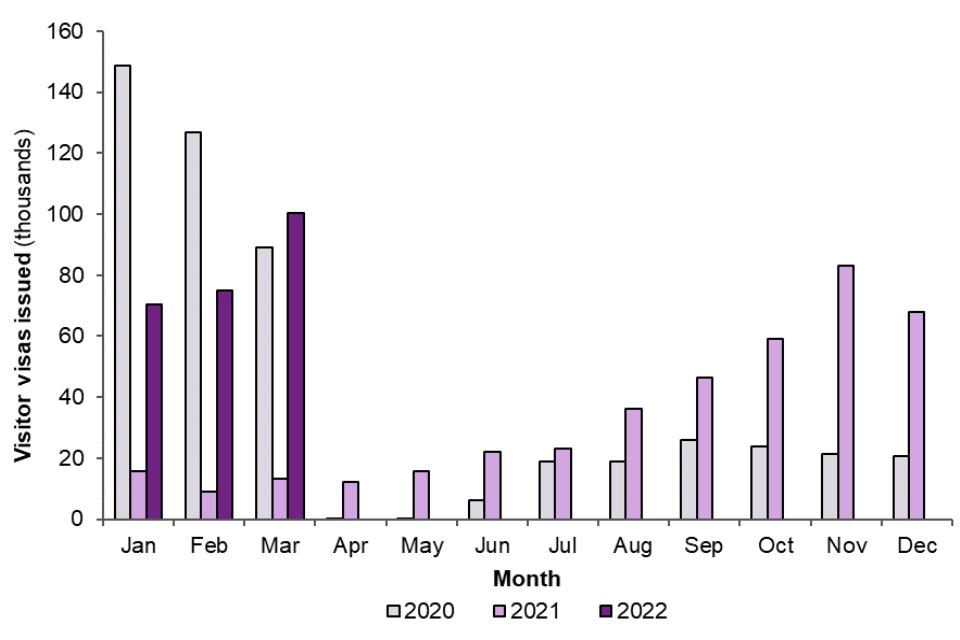How many people come to the UK each year (including visitors)?
Published 26 May 2022
Back to ‘Immigration statistics, year ending March 2022’ content page.
This is not the latest release. View latest release.
Data relate to the year ending March 2022 and most comparisons are with the year ending March 2020 (two years previous, reflecting a comparison with the period prior to the Covid-pandemic). All data include dependents, unless indicated otherwise.
On 11 March 2020, the World Health Organisation (WHO) declared the COVID-19 outbreak as a global pandemic. A range of restrictions were implemented in many parts of the world, and the first UK lockdown measures were announced on 23 March 2020. The COVID-19 pandemic has had a significant impact on the UK immigration system, both in terms of restricting migrant movements to and from the UK and the impact on operational capacity.
Year ending comparisons that follow will include impacts resulting from the restrictions put in place during this period of the pandemic.
This section contains data on:
- Passenger arrivals to the UK
- Grants of Entry clearance visas to individuals outside the UK
- Ukraine schemes
- Visitors to the UK
- British National Overseas (BN(O)) route
1. Passenger arrivals to the UK
There were an estimated 42.9 million passenger arrivals in the year ending March 2022 (including returning UK residents), more than twice as many as in the year ending March 2021 (18.1 million) but less than a third of arrivals in the year ending March 2020 (141.2 million). The differences in the number of passenger arrivals are due to the travel restrictions imposed as a result of the COVID-19 pandemic.
Detailed information on monthly air passenger arrivals during this period is provided in the separate Home Office report Immigration and border statistics relating to COVID-19.
These data show that in the two-year period between April 2020 and March 2022, air passenger arrivals to the UK were, on average, 79% lower than levels seen prior to the COVID-19 outbreak. Air travel to the UK has started to recover in 2022, returning to close to pre-pandemic levels. It reached a two-year high of 7,463,800 in the month of April 2022, with just 18% fewer arrivals than in April 2019 (9,120,400).
Figure 1: Passenger arrivals to the UK, by nationality group1, years ending March 2013 to March 2022

Source: Passenger arrivals (admissions) summary table – Adm_01_q
Notes:
- Nationality breakdowns for 2019 onwards are not available (see ‘Landing cards’ section in the ‘About the Statistics’ section).
Figure 1 shows that, over the last decade, prior to the pandemic arrivals had been increasing each year. However, the number of passenger arrivals decreased sharply following the introduction of COVID-19 travel restrictions from March 2020. Arrivals in the year ending March 2022 were around 30% of the number in a normal year, and this number will include returning British citizens and resident foreign nationals along with any visitors.
Only certain nationalities (‘visa-nationals’) are required to obtain an Entry clearance visa before coming to visit the UK, which is why there are considerably more passenger arrivals than visas granted. There were 1,618,367 visas and permits granted in the year ending March 2022, around half the number (-47%) of the year ending March 2020 (because of the global pandemic), but around two and half times higher (+145%) than the year ending March 2021. Of the visas granted in the latest 12 months, 38% were to visit, 29% were to study, 17% were to work, 3% were for family reasons, and 13% for other reasons.
Figure 2: Total entry clearance visas granted, years ending March 2013 to March 2022

Source: Entry clearance visa applications and outcomes – Vis_D02
Figure 2 shows that the total number of visas granted had been broadly constant between 2013 and 2016 at around 2.5 million and then rose steadily to a high of 3.2 million by 2019. The number then fell significantly due the COVID-19 pandemic, to below 1 million, but has started to see a recovery in the last 12 months as international travel and other restrictions have been lifted.
2. Visitors to the UK
Many nationalities, including US nationals (who accounted for over a quarter of non-EEA passenger arrivals in 2018) do not normally require a visa to visit the UK; consequently, there are considerably fewer Visitor visas granted than visitor arrivals. Nonetheless, from those nationalities required to obtain a visa before visiting the UK, in the year ending March 2021 there were 882,399 applications for Visitor visas, 66% fewer than number in the year ending March 2020, a reduction largely due to the COVID-19 pandemic.
Over the same period, there were 611,539 Visitor visas granted, 74% lower than the year ending March 2020, with the largest falls registered for Chinese (down 565,516 or 97%) and Indian (down 357,796 or 72%) nationals. Together Chinese (3%) and Indian (23%) nationals accounted for 26% of visit visas granted. This is much lower than the proportion seen immediately prior to the pandemic, when Chinese and Indian nationals combined accounted for just under half (47%) of all visit visas granted.
Nigerian (10%) and Saudi (9%) nationals were the second and third largest nationalities and, together, these four nationalities made up almost half (45%) of all visit visa grants in the year ending March 2022.
Additional information on visitors to the UK is published by the Office for National Statistics (ONS) in its publication: Overseas travel and tourism statistics.
Due to the COVID-19 pandemic, visa application centres were closed by 31 March 2020 and only began gradually reopening from June 2020.
Figure 3: Visitor visas issued, by month, 2020, 2021 and 2022

Source: Entry clearance visa applications and outcomes: Vis_D02
As shown in Figure 3, in Q2 of 2020, visitor numbers fell dramatically at the beginning of the global pandemic, with almost no grants in April and May 2020 and only 6,154 grants for the entire quarter. The number of Visitor visa applications granted in each month of the year ending March 2021 was only a small fraction compared to the same month a year earlier.
There was a modest recovery seen in the second quarter of 2021, with further increases in subsequent quarters. Grants of visitor visas in Q1 (January to March) 2022 (245,513) were the highest quarterly figure since before the pandemic, but still a third lower (-33%) of the 364,535 grants seen in Q1 2020. This suggests that visitor numbers are still significantly affected by the COVID pandemic.
3. Ukraine schemes
During March 2022, the UK Government introduced two new routes to allow persons affected by the crisis in Ukraine to come to the UK. Introduced on 4 March 2022, the Ukraine Family Scheme allows applicants to join family members or extend their stay in the UK. The Ukraine Sponsorship Scheme was introduced on 18 March 2022, and allows Ukrainian nationals and their family members to come to the UK if they have a named sponsor under the Homes for Ukraine Scheme.
By 31 March 2022, a total of 60,482 applications has been received across both schemes, of which a total of 27,979 visas had been issued. The latest provisional data is published at Ukraine Family Scheme and Ukraine Sponsorship Scheme: visa data.
The Ukraine Family Scheme had received 29,178 visa applications by 31 March 2022, of which 23,817 visas had been issued.
There were 31,304 Ukraine Sponsorship Scheme visa applications, and 4,162 visas issued, by 31 March 2022. The Sponsorship Scheme commenced less than two weeks before the end of this data collection period and so, as with the Family scheme, the numbers granted do not reflect the outcomes for the majority of applications. Further information on the Ukraine Sponsorship Scheme is available at Ukraine Sponsorship Scheme: Visa data by country, upper and lower tier local authority.
4. British National Overseas (BN(O)) route
On 31 January 2021, the UK Government introduced a new immigration route for British National (Overseas) (BN(O)) status holders from Hong Kong, providing the opportunity for them and their family members to live, work and study in the UK. The data below relates to the year ending March 2022, unless otherwise specified. Data for in country applications is provisional and has been rounded to the nearest hundred. Detailed datasets for out of country applications and grants in this route can be found in entry clearance visa applications and outcomes under the BN(O) route visa type.
There were 19,500 applications for the BN(O) route in Q1 of 2022, with 18,563 out of country applications, and 900 in country applications. Of the total, 11,500 applications relate to main applicants and 8,000 relate to dependants. There have been a total of 123,400 applications for the BN(O) route since its introduction on 31st January 2021 up to the end of March 2022.
There were 16,338 grants of out of country BN(O) visas made in Q1 of 2022, of which 9,688 were for main applicants and 6,650 were for dependants. There were 604 grants of in country BN(O) visas made in Q1 of 2022, of which 323 were main applicants and 281 were dependants. There have been a total of 92,299 grants of out of country BN(O) visas made between 31st January 2021 and 31st March 2022, and a total of 21,443 grants of in country BN(O) visas made between 31st January 2021 to 31st March 2022.
There were 157 out-of-country BN(O) visa refusals, and 2 in-country BN(O) visa refusals in Q1 of 2022.
As expected, the majority of grants (65%) were to BN(O) and/or Hong Kong Special Administrative Region (HKSAR) passport holders. Dependants holding passports for countries other than BN(O) and/or HKSAR accounted for 76% of grants to dependants, including 74% who held Chinese passports.
In 2021, provisional management information shows that 8,350 BN(O) and/or HKSAR passport holders were granted “leave outside the rules” at the UK border.
5. About these statistics
The statistics in this section provide an indication of the number of people who enter the UK.
The data do not show whether, or when, an individual arrived in the UK, what they did on arrival to the UK or how long they stayed in the UK.
During March 2022, the UK Government introduced two new routes to allow persons affected by the crisis in Ukraine to come to the UK. The data in section 3 covers both the Ukraine Family Scheme, which allows applicants to join family members or extend their stay in the UK, and the Ukraine Sponsorship Scheme, which allows Ukrainian nationals and their family members to come to the UK if they have a named sponsor under the Homes for Ukraine Scheme. The finalised data presented in this release will differ from the more timely provisional operational data drawn from live systems, which are subject to change as data is refreshed.
Many nationalities do not normally require a visa to visit the UK. As a result, they will be counted in the passenger arrivals data but not in the visa data. A list of designated nationalities referred to as ‘visa nationals’ who do require a visa in order to visit the UK can be found in Immigration Rules Appendix V: visitor rules.
For several reasons, data on passenger arrivals are not directly comparable with data on Entry clearance visas granted. A summary of what each dataset counts is provided in sections 5.1 and 5.2.
5.1 Passenger arrivals
Data on passenger arrivals relate to the number of arrivals into the UK. The data include British, EEA and Swiss nationals, as well as non-EEA nationals. For non-EEA nationals who are subject to immigration controls, more detailed information is available on their nationality and purpose of their journey up until 2018.
Passenger arrivals are counted each time an individual enters the UK. Where an individual enters the UK more than once in a period, they will be counted each time they enter (but if they arrive each time on the same visa, they will be counted once in the visas data).
Visitor arrivals data included in this topic are based on landing cards completed as people cross the border. In light of the introduction of new digital systems at the border, the use of landing cards was reviewed (see Landing cards). The review resulted in the decision to remove the need for non-EEA nationals to complete a landing card on arrival into the UK. Further data relating to visitor arrivals will not be available until an alternative method of collection is developed.
5.2 Entry clearance visas
Data on Entry clearance visas in this section refer to the number of visas granted for all reasons within the period. If an individual was granted multiple visas in a given period, this will be counted as multiple grants in the statistics. If an individual entered the UK multiple times within the period for which a visa was valid, this will be counted as one grant in the visa statistics, but multiple arrivals in the passenger arrivals data.
Year-on-year comparisons of the number of decisions can be affected by quarterly fluctuations in the data. Such fluctuations can be examined in more detail in the quarterly data that are available in the published tables.
Several known factors may have affected the number of applications and outcomes of visit-related visas over time. For example, the Home Office launched a two-year Chinese visa pilot in January 2016 for Chinese nationals. The increase in longer-term Visitor visas may affect the number of subsequent re-applications by Chinese nationals.
More information on non-visitor arrival and visa data by category is included in ʻWhy do people come to the UK? To work’, ʻWhy do people come to the UK? To study’ and ʻWhy do people come to the UK? For family reasons’.
In January 2021, the UK Government introduced a new immigration route for British National (Overseas) (BN(O)) status holders, providing the opportunity for them and their family members to live, work and study in the UK. This route opened on 31 January 2021 and is open to individuals who hold a BN(O) passport and are, or have recently been, resident in Hong Kong, and their dependants.
5.3 Landing cards
On 5 August 2017, the Home Office launched the ‘Consultation on Home Office’s Immigration Statistics - arrivals data’, on ending the requirement for non-EEA passengers to present a paper landing card on arrival into the UK from 1 October 2017. The consultation set out the statistical implications of the change and closed on 2 September 2017. The government confirmed in the Spring Statement 2019 that to coincide with the ePassport gates expansion, the government would begin to abolish landing cards for non-EEA travellers. On 20 May 2019, it removed the need for all non-EEA travellers to fill in landing cards upon arrival in the UK and expanded the use of ePassport gates to seven more countries. The government’s response to the consultation was published in May 2019. As anticipated in the original consultation, ahead of new electronic data sources being developed, the withdrawal of landing cards has resulted in a temporary loss to the passenger arrivals data broken down by nationality and reason for travel. The last set of published data on non-EEA nationals arriving in the UK (based on Landing Cards), cover the period 2004 to 2018) are available in ‘Immigration statistics, year ending June 2019 second edition’. Data on the total number of passenger arrivals will continue to be available as this comes from a different source.
6. Data tables
- Sponsorship summary tables
- Detailed sponsorship datasets
- Entry clearance visas summary tables
- Detailed Entry clearance visas datasets
- Admissions summary tables
We welcome your feedback
If you have any comments or suggestions for the development of this report, please provide feedback by emailing MigrationStatsEnquiries@homeoffice.gov.uk. Please include the words ‘PUBLICATION FEEDBACK’ in the subject of your email.
We’re always looking to improve the accessibility of our documents. If you find any problems or have any feedback relating to accessibility, please email us.
See section 7 of the ‘About this release’ section for more details.
